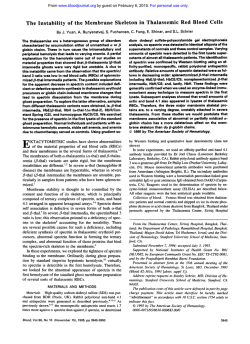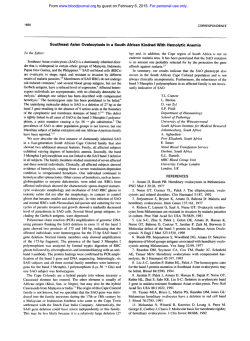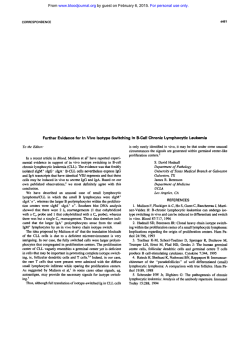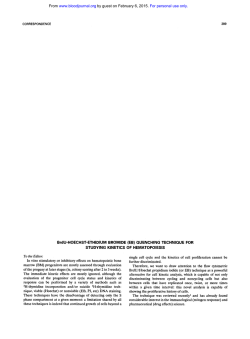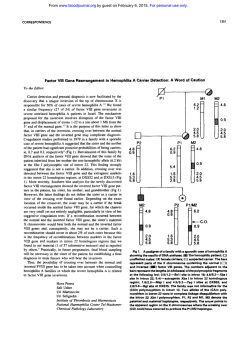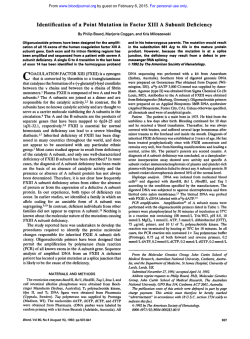
Elliptocytogenic Spectrin Sfax Lacks Nine Amino Acids in
From www.bloodjournal.org by guest on February 6, 2015. For personal use only. Elliptocytogenic Spectrin Sfax Lacks Nine Amino Acids in Helix 3 of Repeat 4. Evidence for the Activation of a Cryptic 5’-Splice Site in Exon 8 of Spectrin a-Gene By F. Baklouti, J. Marechal, R. Wilmotte, N. Alloisio, L. Morle, M.T. Ducluzeau, L. Denoroy, A. Mrad, M.H. Ben Aribia, R. Kastally, and J. Delaunay ElliptocytogenicdiS spectrin Sfax is a new variant found in a Tunisian family. The allele yielded a clinically manifest picture only when occurring in trans to a recently identified, low expression level polymorphism referred to as the av/41 allele. Spectrin dimers were slightly increased in 4°C extracts. On peptide maps, the ad domain split into two abnormal fragments of 36 and 33 Kd. The mutated a-chain and represented 20% and 44% of total a-chain in aV/41/d136 heterozygotes, respectively. Peptide sequencing showed that the 36-Kd fragment started at Ala 357 and displayed a deletion extending from amino acids 363 to 371. The corresponding 27-nucleotide deletion was found in a-spectrin mRNA. However, exon 8 of spectrin a-gene failed to disclose this deletion. Instead, an A to G substitution appeared in position 3 of codon 362, leading to the occurrence of the critical GU dinucleotide within a cryptic 5’-splice site surrounding codon 362. This event would account for the splicing out of codons 363 to 371. The reading frame was preserved and even amino acid 362 (AGG, Arg) remained unaltered. As in most spectrin a-chain elliptocytogenic variants, the change involved a helix 3. This is the first elliptocytogenic mutation recorded in repeat 4. 0 1992 by The American Society of Hematology. H a small segment upstream of repeat a1 that is referred to as repeat al’). More than 10 elliptocytogenic mutations have been described in the a1 domain (repeats a1 to 05 and part of repeat a6). They yield a smaller number of protein phenotypes as defined according to the recommendations of Palek and Lux.I3 Many mutations affect helix 3 of repeats al,14-21a2,10,22,23 a3 and 05.10,22 Other mutations involve helices 2. They are thought to act through a secondary change in the spatially adjacent helix 3, referring to the model proposed by Speicher and Marchesi7 and Tse et a1,12 respectively. A mutation at position 207 concerns helix 2 of repeat aLZ4Various modifications affect helix 2 (and sometimes also helix 1) of repeat P17.12,25-28 spectrin Sfax, the first In this report, we describe elliptocytogenic variant found to affect helix 3 of repeat a4. Amino acids 363 to 371 were skipped, as deduced from peptide and cDNA sequencing. A point mutation (A + G) was evidenced in codon 362 at the gene level. As a result, the surrounding sequence highly matched a 5’-splice site and, most probably, caused the 3‘-end of exon 8 (codons 363 to 371) to be spliced out. EREDITARY elliptocytosis (HE) designates a group of conditions in which the red blood cells (RBCs) are elliptical in shape. Studies at the level of proteins and nucleic acids have shown that HE is highly heterogeneous on a molecular Most of the mutations described thus far affect spectrin, the major RBC skeleton component. Spectrin is a fibrillar heterodimer composed of an a-chain and a P-chain associated in an antiparallel manner. Tryptic peptide mapping has allowed the dissection of spectrin chains into domains, namely a1 to aV and PI to PIV.5 Partial amino acid sequencing provided the basis for the classical n ~ m b e r i n g . ~Later , ~ on, cDNA sequencing showed that the a- and p-chains contain 2429 and 2137 amino acids, r e s p e c t i ~ e l y The . ~ ~ ~exon-intron junctions in spectrin a-gene have been established.lOJ1According to the assumption of Speicher and Marchesi? most parts of a-and P-chains are comprised of 106 amino acid repeats (22 and 17 repeats, respectively). Each repeat has three helical segments designated 3, 1, and 2 (N- to C-terminus of a repeat). At the self-association site, it has been hypothesized that repeat P17 of the P-chain (helices 1 and 2) and repeat a1 of the a-chain (helix 3) combine to form a package of three helices.12(In addition, a-chain contributes CASE REPORTS From CNRS URA 11 71, Facultk de Mkdecine Grange-Blanche; lnstitut Pasteur de Lyon; Service Central d ’Analyse, CNRS, Vemaison, France; and Service d’Himatologie Biologique, Hdpital Habib Thameur, Tunis, Tunisia. Submitted July 25, 1991; accepted January 13, 1992. Supported by the “Universitk Claude-Bemard Lyon-I, ” the “Institut Pasteur de Lyon, ” the Tentre National de la Recherche Scientifique” (URA 1171), the ‘Ynstitut National de la Santk et de la Recherche Mkdicale” (489 NS 3) and the “Caisse Nationale d’Assurance Maladie des Travailleurs Salariks” (Grant 89 69 002). Address reprint requests to J. Delaunay, MD, CNRS URA 1171, Facultk de Mkdecine Grange-Blanche,69373 Lyon C e d a 08, France. The publication costs of this article were defrayed in part by page charge payment. This article must therefore be hereby marked “advertisement” in accordance with 18 U.S.C.section 1734 solely to indicate this fact. @ 1992 by The American Society of Hematology. 0006-4971/92/7909-0026$3.00/0 2464 The affected family is Tunisian family BY living near the city of Sfax. Member 11.1(Table 1) is a boy born in 1980. In the first years of his life, anemia, icterus, and splenomegaly were recorded. Anemia fluctuated between 50 and 100 g hemoglobin (Hb)/L (iron deficiency possibly accounted for such large variations). Elliptocytosis (100%) was recognized in 1984. Presently, the spleen is palpable 6 cm below the costal margin. Routine laboratory parameters are as follows: RBCs, 3.4 x 101*/L;Hb, 107 giL; packed cell volume (PCV), 20%; mean corpuscular volume (MCV), 83 km3; reticulocytes, 10.2 x 109/L(3%); bilirubin, 20 Fmol/L. There is a 100% elliptocytosis with some tendency to bud (Fig 1).The father (1.1) has a moderate spleen enlargement (RBCs, 3.6 X 1012/L;Hb, 115 g/L; PCV, 30%; MCV, 84 pm3; nearly 100% elliptocytosis). It is not known whether the father had a more pronounced anemia in childhood. The mother (1.2) is clinically normal (RBCs, 4.7 x lo’*/ L; Hb, 102 g/L; PCV, 35%; MCV, 74 pm3; anisocytosis with some elliptocytes possibly reflecting iron deficiencyor a mild thalassemia). The subject’s brother (11.2) (Fig 1) and sister (11.3) (not shown) are clinically asymptomatic, have normal RBC indices, and display a Blood, Vol79, No 9 (May I ) , 1992: pp 2464-2470 From www.bloodjournal.org by guest on February 6, 2015. For personal use only. SPLICE SITE ACTIVATION IN ELLIPTOCMOSIS 2465 Table 1. Functionaland Structural Parameters of&- Spectrln Sfax Family Members 1.1 1.2 11.1 11.2 11.3 Controls Year of Birth 1952 1960 1980 1983 1984 Diplotypes aV/41/a1'Jb avl4l/a av/41/d'a a/a'/Jb ala1'= a/3 % PI3 % Spectrin Dimers in Crude Spectrin Extracts, % 39.5t 43.5 41.6t 42.4 43.7 46.2 f 2.1 (n = 5) 38.6 41.0 40.0 39.8 41.8 41.1 f 1.7 (n = 5) 13.2 4.5 13.9 12.7 13.1 6.9 2 1.6 (n = 24) K. Spectrin Sfax (36+ 33)/a1* 1@Llmol % 1.9 4.1 1.7 2.1 2.2 4 . n f 0.68 (n = 43) 42 45 19 21 aV 41-Kd Fragment % 1.5 1.7 1.5 0.8 0.9 The modes of determination of the parameters are given or referred to under Materialsand Methods. "al:Sum of the 80-, 7s. 74-.36-, and 33-Kd fragments. tReduction, significantatP < .01 (t-test). less pronounced elliptocytosis as compared with 1.1 and 11.1. The 4.la/4.lb ratio is sharply reduced in 1.1 and 11.1, and moderately decreased in 11.2 and 11.3 (not shown). It is normal in 1.2. Among other family members, a sister (bom in 1941) of the father (who is the genuine proband) has displayed the same symptomatology as 11.1 and undergone splenectomy in 1976. She was not investigated in the present study. MATERIALS AND METHODS h t e i n analysis. Protein studies were performed in general as previously described or referred to.15.29" Specifically, the electrophoresis of proteins on polyacrylamide gel in the presence of sodium dodecyl sulfate (SDS-PAGE) was performed according to Laemmli3I or Fairbanks et al?* with some modifications.29 The amounts of spectrin a- and pchains were exprcssed with respect to band 3 as the a13 and the 813 percentages, respectively, eg, the ratios (x 100) of optical densities (570 nm) of the corresponding peaks on scanning of the entire gels (3.5% to 17% exponential gradient of acrylamide concentration) according to Fairbanks et al.32The determination of the spectrin dimer percentage in crude extract (4OC) and of the tetramer association constant (K& the one- and two-dimensional maps of spectrin partial digests were also performed with some modifications.*ID Quantification of abnormal bands was done by scanning one-dimensional gels at 570 nm. This method proved to be highly accurate and reliable because spectrin digestion was performed under strictly constant conditions. The aVI4l polymorphism, encoded by the newly identified, low-expression-level aVl4'polymorphism, was quantitated as the ratio of the aV 41-Kd band to all a- and p-chain peptides in I .l Flg 1. Blood smears. 1.1 and 11.1,1W% elliptoqtosir (withsome tendency to bud in 11.1). 1.2, anisocytosis and some elliptocytm (the latter were not related to any detectable mutation). 11.2, moderate elllptocytosir. 11.3 (not shown) is the same as 11.2. n .1 spectrin partial digests (one-dimensional maps)." Low (0.75 f 0.16 [n = 20]), intermediate (1.52 f 0.28 [n = 18]), and high values (3.45 2 0.21 [n = 21) corresponded to the following diplotypes. respectively: a/a, a/av14',and av/41/av/4'.'3 Western blots were performed as reported,I9a following one- and two-dimensional electrophoresis and using anti a1 domain polyclonal antibodies prepared by ourselvesm or kindly provided by Drs J. Palek and J. Lawler. Amino acid sequencing of the 33- and 36-Kd aI bands was performed as previously described.I9 The numbering system is based on the translated amino acid sequence of a-spectrin CDNA,~ which includes six additional amino acid residues compared with previous reports that numbered residues from the first amino acid of the a1 80-Kd domain? Statistical results were expressed as m f standard deviation (SD). The r-test used m f 2SD. cDNA sequencing. Reticulocyte RNA was prepared from peripheral blood as polysomal precipitates and extracted with phenolchloroform-isoamyl alcohol." Reverse transcription (RT) was performed essentially according to Kawasaki3' and Frohman et al,% with some modifications. Two micrograms of RNA was incubated at 42°C for 45 minutes in a mixture (final volume: 20 kL) containing 20 mmol1L Tris HCI (pH 8.4), 50 mmol/L KCI, 2.5 mmol/L MgC12.250 pmollL dNTF', 100 pmol hemmers serving as primers. Fifty units of RNasin and 200 U of Moloney murine leukemia virus reverse transcriptase (GIBCOBRL,Gaithersburg, MD) were used. To perform the polymerase chain reaction (PCR), the mixture was brought to 100 p L so as to contain 20 mmollL Tris HCI (pH 8.4). 50 mmol/L KCI, 2.5 mmollL MgCI2,50 pmol/LdNTP, 0.01% gelatin. Fifty picomoles of primers A and B (Table 2) and 2.5 U of , 1.2 From www.bloodjournal.org by guest on February 6, 2015. For personal use only. BAKLOUTl ET AL 2466 Table 2. Oligonucleotides Used as M m e n or ASOI A B C D CA(GAATTCIGGTGAAGAGlTATGTGCTA* CA(GAAlTC)ATGClTATGCTGCTGATGCt TCCTTCAGATGCACCTCt S'ga(gaattc)atcccaaagGTGAAGGAGT3'* E 5'gc(gaattc)gataggtagagcaataaagg3't F 5'l-lllTCATATCTGCTGGTG3't Normal anticodon 362 5'l-lllTCATACCXCTGGTG3't Mutated anticodon 362 G C = Lower case letterscorrespondto intronic sequences. (10) In Parentheses, linker EcoRl site. D,capital letters represent the 5'-end of exon 8. *Sense. tAntisense. Taq polymerase (Perkin Elmer Cetus, Nonvalk, CT) were added. The mixture was submitted to 30 cycles of amplification: denaturation (92"C, 60 seconds), annealing (55°C. 30 seconds), and extension (72OC, 60seconds). The first cycle started with a 5 minute denaturation step. After the last cycle, the mixture was incubated at 72°C for 5 minutes. PCR-amplified DNA fragments were controlled using electrophoresis in 4% Nu sieve GTG agarose (FMC Bioproducts, Rockland, ME) and ethidium bromide staining. Thereafter, another set of 30 cycles (same cycles as above) was performed with a 100 to 1 excess of primer B with respect to primer A so as to generate an excess of the antisense strand. Unincorporated PCR primers were removed using the Prep-A-gene-DNA purification kit (Biorad, Richmond, CA). The single-strand PCR product was sequenced3' using primer C (Table 2), according to the Sequenase kit specifications. Genomic DNA sequencing. A genomic DNA segment containing a-spectrin exon 8 was PCR-amplified using oligonucleotides D and E (denaturation: 92"C, 60 seconds; annealing: 53T, 90-second extension: 72"C, 90 seconds). The 215-bp amplified fragment (proband) was cloned as EcoRI inserts in phage M13mpl8 as described earlierz1and sequenced (see above). Dof-b!ot analysis. PCR products were analyzed by dot blot using allele specific oligonucleotides (ASO) F and G (Table 2). The AS0 were radioactively labeledz1or labeled using dUTP-I 1digoxigenin and subsequently revealed as referred to elsewhere.% RESULTS Protein unulysk. Membrane protein SDS-PAGEwas normal (not shown). No truncated achain could be detected. Spectrin a-chain tended to be decreased (Table l); however, the reduction was significant ( < m - 2SD; P < .01) only in 1.1 and 11.1. A limited increase of spectrin dimers was noted in crude extracts (4°C) (Table 1) in all carriers. The spectrin tetramer association constant was more conspicuously altered, especially in 1.1 and 11.1 (Table 1). One-dimensional peptide maps showed two abnormal bands of 36 and 33 Kd (Fig 2). The new bands developed at the reciprocal expense of the a1 80- and 74-Kd bands. This suggested that they derive from the a1 domain, hence the designation of the variant.13 The two bands were quantitated as the (36 + 33)/(80 + 78 + 74 + 36 + 33) percentage, eg, the (36 + 33)/aI percentage (Table 1).Both of them were more conspicuous in 1.1 and 11.1 than in 11.2 and 11.3 (Table l), because of the presence of the aVI4l allele33 in trunr of the ~ ~ 1allele % in the two former persons Fig 2. One-dimensionai peptide maps of d'm spectrln Sfax. The d 3&Kd and al 33-Kd fragments (designated by arrowheads) chamcterize spectrin Sfax. They are more pronounced in 1.1 and 11.1 (W than in 11.2 and 11.3 (D). The a"'" polymorphism (in the heterozygous state) is indicated by an arrow in 1.1,1.2 and 11.1. C, control. (intermediate amount of the aV 41-Kd fragment). In 11.3, the a'/% chains accounted for -20% of total a-chains. In av/41/a1/36 individuals 1.1 chains accounted for -44% of total and 11.1, the a-chains. Two-dimensional peptide maps (Fig 3) showed horizontal triplication of the 36-Kd spot (PI: 4.75 to 4.90) and duplication of the 33-Kd spot (PI: 5.30 to 5.40), respectively. These changes strikingly resembled the triplication of the a1 50-Kd spot in a1150a spectrin and the duplication of the a1 50-Kd spot in spectrin.' The heterogeneity of p1 may reflect alternative cleavages after arginyl and/or lysyl residues that would be close to one another. However, amino acid sequencing of the 33- and 36-Kd bands following one-dimensional electrophoresis indicated that the corresponding N-terminal regions are homogeneous (see below). After one- and two-dimensional electrophoresis, tryptic peptides of spectrin were transferred to Immobilon filters (Millipore, Bedford, MA) and blotted with polyclonal antibodies generated to aI-domain. In addition to the expected (a1 80 - a1 78) and a1 74-Kd peptides, the 36-Kd a/a11% individuals 11.2 and =89 -30 Fig 3. Two-dimensional peptide maps, and one- and two-dimensional immunobiots. 1.1 was investigated. Left, squares Indicate the 36- and 33-Kd spots. Right, the ai 36-Kd fragment(s), but not the d 33-Kd fragment(s), reactedwith anti-rd-domain polyclonal antibodies. Under the conditions used, the al 78-Kd fragmentwas fused with its d 80-Kd parent fragment. In two-dimensional immunoblots, several al domain additional spots developed; however, their precise locationin the al domain was not identified. From www.bloodjournal.org by guest on February 6, 2015. For personal use only. 2467 SPLICE SITE ACTIVATION IN ELLIPTOCYTOSIS Heteroduplexes 1 296 bp - \ 269 bP Flg 4. Electmphomtlc analyrls of cr.pschin mRNA RT-PCR product. Member 1.1 was investigated. Three major bands are evidenced: lower band (269 nt); intennediay band (296 nt); higher bands (that represent heteroduplexes of the precedingfragments). peptide gave a positive reaction with antibodies prepared by ourselves (not shown) or kindly provided by Drs J. Palek and J. Lawler (St Elizabeth’s Hospital, Boston, MA) (Fig 3). On the other hand, the 33-Kd fragments failed to react with any of the two antiserums used. Because the 36- and 33-Kd band intensities behaved in a parallel manner, we considered that the 33-Kd fragment derived also from the a1 domain. For some reason, this fragment would be poorly immunogenic. Partial N-terminal amino acid sequencing ascertained the a1 domain origin of the 36-Kd fragment (see below). It also indicated that the N-terminal sequence of the 33-Kd fragment is: E-WESS-P (amino acids 7 to 15 G A T of spectrin a-chain; -: unidentified residues). The sum of the molecular weights of both 36- and 33-Kd fragments did not equal 80 Kd. This may arise from uncertainties in molecular weight estimation after SDS-PAGE. On the other hand, we cannot rule out that some peptide(s) was (were) further degraded and disappeared. Because of numerous bands in this region, Coomassie blue staining did not show 27-Kd peptide that would be to the 33-Kd peptide what the 74-Kd peptide is to the 80-Kd peptide. Partial N-terminal amino acid sequencingof the a1 36-Kd fragment showed that an abnormal cleavage, not normally seen, occurred after Arg 356 (helix 3, repeat 4). A few amino acids downstream, a nine-residue sequence was missing. This sequence could correspond either to amino acids 363 to 371 (YEKLQATYW) or those extending from positions 364 to 372 (EKLQATYWY). Further studies showed that the first possibility is correct (see below). cDNA sequencing. After RT and the first set of PCR cycles, DNA fragments were analyzed (Fig 4). Three bands were visible. Sequencing, performed after a subsequent set of asymetrical PCR (see Materials and Methods), showed the following. The lower band (269 nt) disclosed a 27-nt deletion that corresponded to one (YEKLQATYW) of the two amino acid sequences considered above (Fig 5). Therefore, the lacking portion definitely represented the 3’ region of exon 8. The intermediary band (296 nt) had a normal sequence (not shown). It is noteworthy that we found no detectable amount of G at position 3 of codon 362 (see below). The upper band, that was duplicated, represented heteroduplexes between strands of the lower and intermediary bands. The sequence of the upper band was normal down to position 2 (included) of codon 362. Further, it became duplicated, combining the normal sequence (3’ region of exon 8) and the sequence following the deletion (5’ region of exon 9 ) (not shown). A Pst I site encompassing codons 366 and 367 was abolished in the intermediary band, but not in the upper or lower bands. Genomic DNA sequencing. Genomic DNA of the proband was PCR amplified into a 215-bp band (primers D and E). Sequencing did not show the expected deletion within exon 8. Instead, we noted the A to G substitution (three clones out of five) at position 3 of codon 362 (AGA --* AGG) (Fig 5). Dot-blot hybridization experi- C A J A A T B C 7 g - e n t Fig 5. DNA sequencing. 11.1 was Investigated. Left: cDNA; direct sequencing of the lower band seen in Fig 4-0 27-ntdeletion Is visible. Right, sequencing of exon 8 after cloning in phage M13. A A G T A A C C T G E-AA C C G G A C A ] 362 AGA 4 AGG From www.bloodjournal.org by guest on February 6, 2015. For personal use only. BAKLOUTI ET AL 2468 I .1 n .2 .1 .2 N .3 : M Fig 6. Dot-blot analysh of PCR-amplifiedaxon 8. N, normal ASO: M, mutated ASO. 1.1, 11.1, 11.2, and 11.3 carry the d's allele. The A S 0 were labeled with ll-digoxlgenln dUTP. ments supported the view of the association of this change to ailx spectrin (Fig 6). The point mutation generates the following sequence surroundingcodon 362 CAGGUAUGA (in the mRNA), which is close to the 5'-splice site consensus sequence; 5&G/gu;aguP9 The A + G change creates the highly invariant dinucleotide/gu. We inferred that it resulted most likely in the activation of a cryptic 5'-splice site at codon 362 and in the splicing out of the downstream sequence of exon 8. The mRNA deletion preserved the reading frame downstream as nt 1 of exon 9 became nt 3 of new codon 362. Furthermore, the latter still encoded Arg (AGA + AGG). Figure 7 summarizes the mechanism by which the 9 amino acid deletion would stem from the point mutation. Dot-blot analysis of total RT-PCR product using radioactively labeled oligonucleotide G failed to show any substantial amount of a cDNA species that would carry the A + G substitution seen at the gene level, but would have escaped abnormal splicing (not shown). DISCUSSION Elliptocytogenic mutations of the a1 domain have been found previously in repeats 1, 2, 3, and 5, respectively. To our knowledge, al'% spectrin Sfax is the first a-chain elliptocytogenicvariant to be recognized in repeat a4. As with most variants, the present one involves a helix 3, refemng to the model of Speicher and Marchesi.7 The small but significant reduction of spectrin a-chain in 1.1 and 11.1 has an uncertain meaning. Under our experimental conditions, we observed a comparable decrease in other &MA ACC KG TAT O M Intron 0 Exon 9 371 362 363 A M Cn; C f f i CCT A C T TAT E-6 TAC CAT HE cases (reference 15, and manuscript in preparation). Given the molecular weights and the pl of the abnormal fragments, spectrin Sfax is different from the variant described by Lambert and ZaiL4)The present family is one in which the clinical, morphological, and biochemical manifestations of HE, associated with an a-spectrin variant, are enhanced by the presence, in trans, of the low expression level aVl4'allele?3 Concerning dimer self-association,spectrin Sfax resembles spectrin.4' On the other hand, the percentages of spectrin Sfax (approximately 20% and 44%, depending on the absence or the presence of the aVl4' polymorphism in trans, respectively) were lower than those of spectrin under the same conditions (44% and 62%, respectively)!' The 9 amino acid deletion was accounted for by a 27-nt deletion in a-spectrin cDNA. This deletion corresponds to the 3' region of exon 8. Sequencing of genomic DNA disclosed, instead of the deletion, a silent single substitution within codon 362. The latter was assumed to be responsible for the activation of a surrounding cryptic 5'-splice site, on the basis of the following. (1) It has been demonstrated that the consensus sequence is complementaryto the 5' first 9 nt of U1 small nuclear RNA (snRNA) and that base pairing of these two RNAs is required for pre-mRNA splicing:* the most invariant positions being the nearly universal GU dinucleotide at the cleavage site and the guanosine at position +5?9 Spectrin Sfax mutation precisely generates the GU dinucleotide within the new 5'-splice site. (2) It is known that mutations which increase the complementarity of a site to U1 snRNA lead to a corresponding increase in the activity of the site for ~plicing,4~-"the splice site selection becoming a spliceosome competition process." (3) The authentic 5'-splice site at the exon 8-intron 8 boundary in the a-spectrin gene displays a poor homology with the consensus sequence as it deviates at four positions, whereas the vast majority of natural 5'-splice sites deviate at two or three positions, if any?9*45.46 On the other hand, the cryptic site at the mutated codon 362 deviates only at two positions. Remarkably, the abnormally spliced mRNA generates a sufficient amount of a pathological, yet viable, protein product. We were unable to evidence any mRNA carrying no deletion, but having G instead of A at position 3 of codon 362. We infer that splicing takes place with a high efficiency at the activated site so that the latter competes favorablywith the normal site. In this report, we have described ailM spectrin Sfax. The molecular lesion is the deletion of amino acids 362 to 371. It stems from the activation of a 5'-splice site, due to the A to G substitution in position 3 of codon 362 of spectrin a-chain cDNA. ACKNOWLEDGMENT Fig7. Schemdc mpresentatlonofthe a h r e d splklng of exon 8 In spectrln Sfax. Underlined (full line) sequence, normally used 5'-splice site. Underlined (dotted line) sequence, cryptic 5'-splice site. 1, base substitution. We thank family BY for their kind cooperation, Drs J. Palek and J. Lawler for their generous gift of an antial domain antiserum, Drs A. and H. Hafsia for their help, Dr F. MorIC for critical advice, and C. Aragon for preparing the manuscript. From www.bloodjournal.org by guest on February 6, 2015. For personal use only. 2469 SPLICE SITE ACTIVATION IN ELLIPTOCYTOSIS REFERENCES 1. Marchesi SL: The erythrocyte cytoskeleton in hereditary elliptocytosis and spherocytosis, in Agre P, Parker JC (eds): Red Blood Cell Membranes. New York, NY,Dekker, 1988, p 77 2. Delaunay J, Alloisio N, Mor16 L, Pothier B: The red cell skeleton and its genetic disorders. Mol Aspects Med 11:161,1990 3. Palek J, Lambert S: Genetics of the red cell membrane skeleton. Semin Hematol27:290,1990 4. Gallagher PG, Tse WT, Forget BG: Clinical and molecular aspects of disorders of the erythrocyte membrane skeleton. Semin Perinatol14:351,1990 5. Speicher DW, Morrow JS, Knowles WJ, Marchesi VT: A structural model of human erythrocyte spectrin: Alignment of chemical and functional domains. J Biol Chem 2579093,1982 6. Speicher DW, Davies G, Marchesi VT: Structure of human erythrocyte spectrin. 11. The sequence of the a1 domain. J Biol Chem 258:14938,1983 7. Speicher DW, Marchesi V T Erythrocyte spectrin is comprised of many homologous triple helical segments. Nature 311: 177,1984 8. Sahr KE, Laurilla P, Kotula L, Scarpa AL, Coupal E, Leto TL, Linnenbach AJ, Winkelmann JC, Speicher DW, Marchesi VT, Curtis PJ, Forget BG: The complete cDNA and polypeptide sequences of human erythroid a-spectrin. J Biol Chem 2654434, 1990 9. Winkelmann JC, Chang JG, Tse WT, Scarpa AL, Marchesi VT, Forget BG: Full length sequence of the cDNA for human erythroid P-spectrin. J Biol Chem 265:11827,1990 10. Sahr KE, Tobe T, Scarpa A, Laughinghouse K, Marchesi SL, Agre P, Linnenbach AJ, Marchesi VT, Forget B: Sequence and exon-intron organization of the DNA encoding the a1 domain of human spectrin. Application to the study of mutations causing hereditary elliptocytosis. J Clin Invest 84:1243,1989 11. Kotula L, Laury-Kleintrop LD, Showe L, Sahr K, Linnenbach AJ, Forget B, Curtis PJ: The exon-intron organization of the human erythrocyte a-spectrin gene. Genomics 9:131,1991 12. Tse WT, Lecomte MC, Costa FF, Garbarz M, Feo C, Boivin P, Dhermy D, Forget BG: Point mutation in the p-spectrin gene associated with aI/74 hereditary elliptocytosis. Implications for the mechanism of spectrin dimer self-association. J Clin Invest 86:909, 1990 13. Palek J, Lux S: Red cell membrane skeletal defects in hereditary and acquired hemolytic anemias. Semin Hematol 20: 189,1983 14. Garbarz M, Lecomte MC, Fbo C, Devaux I, Picat C, Lefebvre C, Galibert F, Gautero H, Bournier 0, Galand C, Forget BG, Boivin P, Dhermy D: Hereditary pyropoikilocytosis and elliptocytosis in a white French family with variant related to a CGT to CAT codon change (Arg to His) at position 22 of the spectrin a1 domain. Blood 751691, 1990 15. Baklouti F, MarCchal J, Mor16 L, Alloisio N, Wilmotte R, Pothier B, Ducluzeau MT, Kastally R, Delaunay J: Occurrence of the a1 22 Arg His (CGT CAT) spectrin mutation in Tunisia: Potential association with severe ellipto-poikilocytosis.Br J Haemato1 78:108, 1991 16. Coetzer TL, Sahr K, Prchal J, Blacklock H, Peterson L, Koler R, Doyle J, Manaster J, Palek J: Four different mutations in codon 28 of a spectrin are associated with structurally and functionally abnormal spectrin aI/74 in hereditary elliptocytosis. J Clin Invest 88:743,1991 17. Floyd BP, Gallagher PG, Valentino LA, Davis M, Marchesi SL, Forget BG: Heterogeneity in the molecular basis of hereditary pyropoikilocytosis associated with increased levels of the spectrin aI/74-kilodalton tryptic peptide. Blood 78:1364,1991 - 18. Mor16 L, Alloisio N, Ducluzeau MT, Pothier B, Blibech R, Kastally R, Delaunay J: Spectrin Tunis (a1i78): A new a1 variant that causes asymptomatic hereditary elliptocytosis in the heterozygous state. Blood 71:508,1988 19. Mor16 L, Mor16 F, Row AF, Godet J, Forget BG, Denoroy L, Garbarz M, Dhermy D, Kastally R, Delaunay J: Spectrin Tunis (S~a’/~8), an elliptocytogenic variant, is due to the CGG + TGG codon change (Arg + Trp) at position 35 of the a1 domain. Blood 742328,1989 20. Lecomte MC, Garbarz M, Grandchamp B, FCo C, Gautero H, Devaux I, Bournier 0, Galand C, d’Auriol L, Galibert F, Sahr KE, Forget BG, Boivin P, Dhermy D: A mutation of the a1 spectrin domain in a white kindred with H E and HPP phenotypes. Blood 74:1126,1989 21. MorlC L, Row AF, Alloisio N, Pothier B, Starck J, Denoroy L, Mor16 F, Rudigoz RC, Forget BG, Delaunay J, Godet J: Two elliptocytogenic a1/74 variants of the spectrin a1 domain. Spectrin Culoz (GGT- GTT; a1 40 Gly+Val) and spectrin Lyon (CM -+ TTT; a1 43 Leu --* Phe). J Clin Invest 86548,1990 22. Marchesi SL, Letsinger JT, Speicher DW, Marchesi VT, Agre P, Hyun B, Gulati G: Mutant forms of spectrin a-subunits in hereditary elliptocytosis. J Clin Invest 80:191,1987 23. R o w AF, Mor16 F, Guetarni D, Colonna P, Sahr K, Forget hereditary BG, Delaunay J, Godet J: Molecular basis of Sp a1/65 elliptocytosis in North Africa: Insertion of a ‘ITG triplet between codons 147 and 149 in the a-spectrin gene from five unrelated families. Blood 73:2196,1989 24. Gallagher PG, Tse WT, Coetzer T, Lawler J, Zarkowsky HS, Lecomte MC, Dhermy D, Baruchel A, Marchesi SL, Garbarz M, Palek J, Forget BG: A common mutation in aI/46-50a kD hereditary elliptocytosis (HE) and hereditary pyropoikilocytosis (HPP) distant from the associated spectrin proteolytic cleavage site. Blood 76:7a, 1990 (abstr, suppl) 25. Garbarz M, Tse WT, Gallagher PG, Picat C, Lecomte MC, Galibert F, Dhermy D, Forget BG: Spectrin Rouen (P220-218),a novel shortened P-chain variant in a kindred with hereditary elliptocytosis. 11. Characterization of the molecular defect as exon skipping due to a splice site mutation. J Clin Invest 88:76,1991 26. Tse WT, Gallagher PG, Pothier B, Costa FF, Scarpa A, Delaunay J, Forget BG: An insertional frameshift mutation of the P-spectrin gene associated with elliptocytosis in spectrin Nice (P220/216).Blood 78:517, 1991 27. Yoon SH, Yu H, Eber S, Prchal J T Molecular defect of truncated P-spectrin associated with hereditary elliptocytosis. P-Spectrin Gottingen. J Biol Chem 26623490,1991 28. Gallagher PG, Tse WT, Costa F, Scarpa A, Boivin P, Delaunay J, Forget BG: A splice site mutation of the P-spectrin gene causing exon skipping in hereditary elliptocytosis associated with a truncated p-spectrin chain. J Biol Chem 266:15154,1991 29. Alloisio N, Mode L, Pothier B, Roux AF, Martchal J, Ducluzeau MT, Benhadji-Zouaoui Z, Delaunay J: Spectrin Oran ( ( I I I / ~ ~ ) , a new spectrin variant concerning the a11 domain and causing severe elliptocytosis in the homozygous state. Blood 71:1039,1988 30. Pothier B, Alloisio N, MarCchal J, Mor16 L, Ducluzeau MT, Caldani C, Philippe N, Delaunay J: Assignment of hereditary elliptocytosis to the a- or the P-chain of spectrin through in vitro dimer reconstitution. Blood 75:2061, 1990 31. Laemmli U K Cleavage of structural proteins during the assembly of the head of bacteriophage T4. Nature 227:680,1970 32. Fairbanks G, Steck TL, Wallach DFH: Electrophoretic analysis of the major polypeptides of the human erythrocyte membrane. Biochemistry 10:2606,1971 From www.bloodjournal.org by guest on February 6, 2015. For personal use only. 2470 33. Alloisio N, Mor16 L, MarCchal J, Roux AF, Ducluzeau MT, Guetarni D, Pothier B, Baklouti F, Ghanem A, Kastally R, Delaunay J: S P ~ ~ ’ ~ A ’ common : spectrin polymorphism at the aIV-aV domain junction. Relevance to the expression level of hereditary elliptocytosis due to a-spectrin variants located in trans. J Clin Invest 87:2169,1991 34. Kan YW, Holand JP, Dozy AM, Varmus H Demonstration of non-functional Po-thalassemia. Proc Natl Acad Sci USA 72:5140, 1974 35. Kawasaki ES: Sample preparation from blood, cells, and other fluids, in Innis MA, Gelfand DH, Sninsky JJ, White TJ (eds): PCR Protocols. A Guide to Methods and Applications. San Diego, CA, Academic, 1990, p 21 36. Frohman MA, Dush MK, Martin GR: Rapid production of full-length cDNAs from rare transcripts: Amplification using a single gene-specific oligonucleotide primer. Proc Natl Acad Sci USA 8523998,1988 37. Sanger F, Nicklen S, Coulson AR: DNA sequencing with chain-terminating inhibitors. Proc Natl Acad Sci USA 74:5463, 1977 38. Miraglia del Giudice E, Ducluzeau MT, Alloisio N, Wilmotte R, Delaunay J, Perrotta S, Cutillo S, Iolascon A Hereditary elliptocytosis in Southern Italy. Evidence for an African origin. Hum Genet (in press) BAKLOUTI ET AL 39. Mount SM: A catalogue of splice junction sequences. Nucleic Acids Res 10459,1982 40. Lambert S, Zail S: A new variant of the a subunit of spectrin in hereditary elliptocytosis. Blood 69:473, 1987 41. Alloisio N, Guetarni D, Mor16 L, Pothier B, Ducluzeau MT, Soun A, Colonna P, Clerc M, Philippe N, Delaunay J: hereditary elliptocytosis in North Africa. Am J Hematol 23:113, 1986 42. Zhuang Y, Weiner AM: Compensatory base change in U1 snRNA suppresses a 5’ splice site mutation. Cell 46:827,1986 43. Aebi M, Hornig H, Weissmann C: 5’ Cleavage site in eukaryotic pre-mRNA splicing is determined by the overall 5’ splice region, not by the conserved 5’GU. Cell 50:237,1987 44. Nelson KK, Green MR: Mechanism for cryptic splice site activation during pre-mRNA splicing. Proc Natl Acad Sci USA 87:6253,1990 45. Ohshima Y, Gotoh Y: Signals for the selection of a splice site in pre-mRNA. Computer analysis of splice junction sequences and like sequences. J Mol Biol195:247,1987 46. Shapiro MB, Senapathy P: RNA splice junctions of different classes of eukaryotes: Sequence statistics and functional implications in gene expression. Nucleic Acids Res 15:7155, 1987 From www.bloodjournal.org by guest on February 6, 2015. For personal use only. 1992 79: 2464-2470 Elliptocytogenic alpha I/36 spectrin Sfax lacks nine amino acids in helix 3 of repeat 4. Evidence for the activation of a cryptic 5'-splice site in exon 8 of spectrin alpha-gene F Baklouti, J Marechal, R Wilmotte, N Alloisio, L Morle, MT Ducluzeau, L Denoroy, A Mrad, MH Ben Aribia and R Kastally Updated information and services can be found at: http://www.bloodjournal.org/content/79/9/2464.full.html Articles on similar topics can be found in the following Blood collections Information about reproducing this article in parts or in its entirety may be found online at: http://www.bloodjournal.org/site/misc/rights.xhtml#repub_requests Information about ordering reprints may be found online at: http://www.bloodjournal.org/site/misc/rights.xhtml#reprints Information about subscriptions and ASH membership may be found online at: http://www.bloodjournal.org/site/subscriptions/index.xhtml Blood (print ISSN 0006-4971, online ISSN 1528-0020), is published weekly by the American Society of Hematology, 2021 L St, NW, Suite 900, Washington DC 20036. Copyright 2011 by The American Society of Hematology; all rights reserved.
© Copyright 2026
